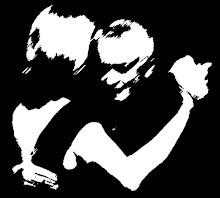Recently a relatively new member of our tango community was asking me about the cabeceo and tango etiquette. As we chatted, he commented on the strong similarities between good manners relating to conversation and tango.
This got me thinking, and I decided to design a little quiz. Here goes:
Before trying to engage a person in conversation, do you ...
- look at them first to see if they might be interested in engaging with you?
- tap them on the shoulder and expect them to want to talk to you?
- interrupt that conversation and take over?
- wait until that person is 'free' & looks interested in talking to you?
- do you really listen to them?
- are you planning what you want to say next, while they are still speaking?
- talk at length, without allowing them opportunity to engage in the conversation?
- express an idea, listen to their response, and then respond to that?
Does it sound like tango to you, too? Perhaps you might think of something to add to the quiz.
PP

Maybe you should introduce the most basic element the pause, take a moment before you start by acknowledge those around the table especially, if that person has a partner next to them.
ReplyDeleteBe aware of your sounding otherwise the way you treat others is the way they will treat you.
Thanks for your comment, Anonymous, and for adding to my list.
ReplyDeleteWhat you describe appears to be good manners, if you were using the direct approach when inviting someone to dance. But, in my opinion, the main recipients of your good manners would be the other people at the table, not the invitee. However, if the invitee has somehow already indicated their interest in dancing with you, that's a different matter. Furthermore, if they are with a partner, you might also comment to the partner afterwards, how much you enjoyed the tanda.
Unfortunately, if the invitee has not already shown interest in dancing with you, the direct approach doesn't allow him/her to decline your invitation without causing embarrassment and discomfort. Hence, the value of the cabeceo.
Nobody is perfect. We can all make mistakes. The best things to do are to read body language, size up the situation and do your best to ensure that feelings are not hurt.
PP